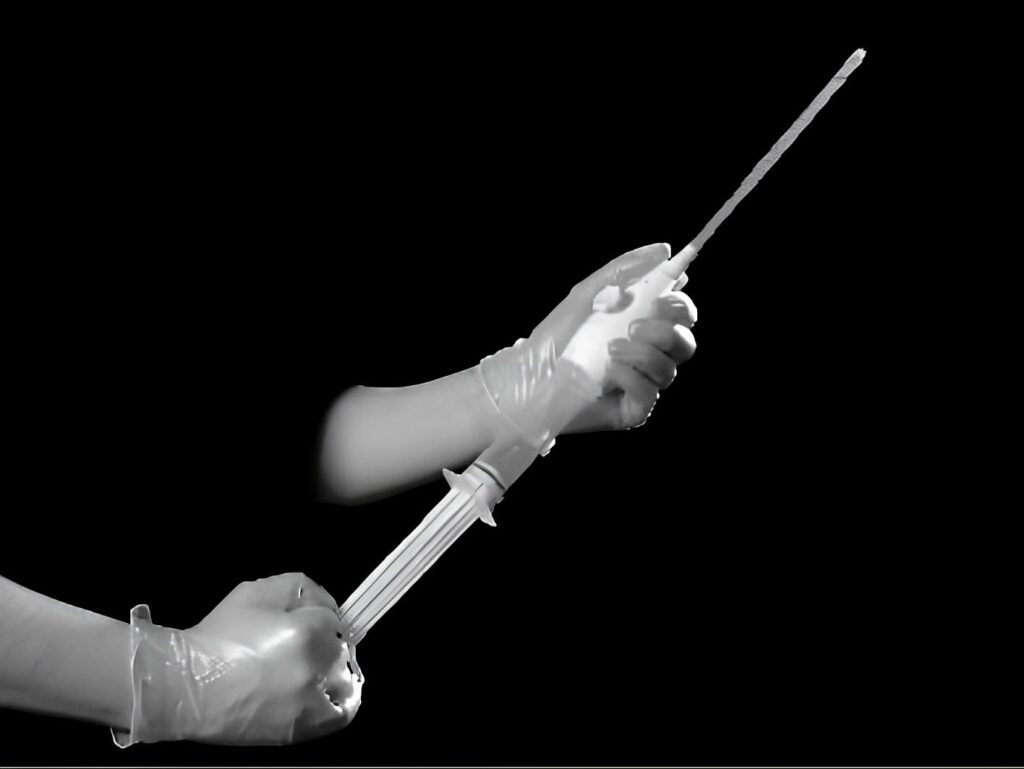Your average person doesn’t know what a manual vacuum aspirator (MVA) is, or how it is used to perform abortions. Even some pro-lifers may not have heard of MVAs. But women around the world on the receiving end of U.S.-funded population control programs certainly do. There are millions of these handheld suction abortion devices in use around the world. And the abortion movement is eager to make this kind of abortion just as common in the U.S.
A manual vacuum aspiration abortion uses a bicycle-pump-like device to that manually sucks out the contents of the uterus–those contents being a baby and the supporting placenta. The MVA itself looks like a large plastic syringe with a long tube, called a cannula, attached. The end of the cannula has small, sharp side slits just big enough to slice off bits and pieces of the baby until it is all gone.
All of this is a lot like a standard electric vacuum aspiration abortion, but with one difference: a manual vacuum aspirator requires no electricity. For this reason, containerloads of this nasty little device are sent to developing countries all around the world to be used in rural areas without power.
There is a dispute over who exactly invented the MVA. FDA officials told PRI President Steven Mosher that the MVA was invented and first used in 1927 by S. G. Bykov in the Soviet Union. Why am I not surprised that a communist country claims to have invented this murderous little device.
But another communist country also wants credit as well. Communist China points to a paper published by two Chinese abortionists in 1958 on the MVA to suggest that it, not the Soviet Union, was the first to popularize the use of the device. The Chinese abortionists claimed that it could be used up to 60 times on one woman. They did not claim to have invented the method, which they probably learned from their Soviet allies, but they were the first to produce an academic paper on the topic. Untranslated, their paper did not come to public notice outside of China until decades later.
In any event, MVA abortions became common in communist countries years before the idea reached the West. Communist China, in particular, “was very keen to reduce population, so both contraception and abortion were widely used—there was considerable emphasis on women having an abortion.”
When MVA abortions finally did reach the U.S. in the 1970s, it was promoted using the revolting catch-phrase the “lunch-hour abortion.”
Ipas, the main promoter and producer of MVAs was founded in North Carolina at that time. Today, this pro-abortion organization continues to work with the United Nations Population Fund (UNFPA) to spread MVAs all over the world resulting in the deaths of countless unborn children.
There are many questions surrounding the safety of the MVA, the harm they may visit upon vulnerable women, and they way contribute to the spread of disease around the globe. Some MVAs are designed for one-time use only, while others are designed to be reused after they are properly sterilized. In poor developing countries, however, the sanitation guidelines are often ignored. The devices are simply used and reused until they eventually break, despite the risks to the mothers involved.
At present, the U.S. pro-abortion movement is engaged in an effort to promote the use of the MVA in our own country, and effort that is picking up steam as various states and federal judges rule against the use of the abortion pill. Abortion activists tout that MVAs are so easy to use that women can do abortions on themselves, a truly revolting idea.
The MYA Network, for example, wants to bring “Manual Uterine Aspiration” to every state, even to those where abortions are illegal. Dr. Joan Fleishman, co-founder of MYA Network supports using MVAs for what she calls “menstrual regulation”, which is a euphemism for an early abortion, performed prior to taking a pregnancy test, when a young woman’s period is late. She also speaks of the “necessity of self-managed abortion.”
Another U.S.-based group, the Reproductive Health Access Project (RHAP), has for many years held classes on how to perform an MVA abortion. When these began in 2005 they were limited to medical practitioners, but since 2014 have been offered to the general public. No medical degree or training required.
The classes illustrate an MVA abortion by substituting a papaya for a uterus, and sucking out the seeks. After one such demonstration of how to evacuate a papaya of its seeds, the instructor claimed “It’s even more satisfying when it’s a real abortion.”
We at PRI have worked for decades to get MVAs out of developing countries. Now, we need to work together to keep them out of our nation as well.
We at PRI have prepared a new fact sheet on the MVAs that you can access here. Arm yourself, your friends, and your family, with the information needed to stop this new attack on the unborn.











